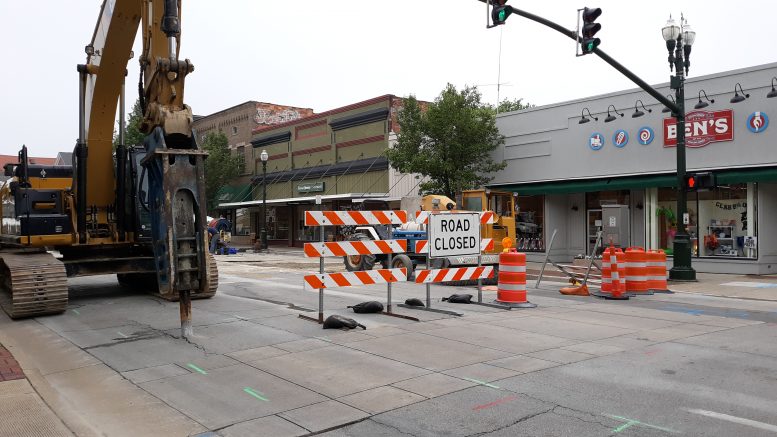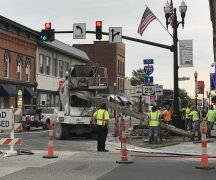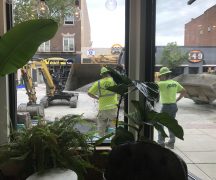By JAN LARSON McLAUGHLIN
BG Independent News
The news was not unexpected, but it was unwelcomed. The construction projects in downtown Bowling Green are behind schedule – and likely won’t be done for several more months.
Bowling Green Municipal Administrator Lori Tretter broke the news to City Council Monday evening.
The contractors have been made aware of community events that use the downtown streets – like the monthly Firefly Nights in the summer and the Black Swamp Arts Festival in the fall. In those cases, the contractors know to “button it up,” so there are no open holes in the downtown during those events, Tretter said.
“It’s a tradeoff,” she said, explaining the city doesn’t want to slow down progress of the work, but it also has no intention of canceling community events that use the downtown.
Part of the delay is due to two projects going on back-to-back in the downtown – with one contractor working on connecting water lines, while another is focusing on sidewalks and street pavements.
Then, of course, there’s the weather this spring, with an abnormal amount of rainy days.
“The weather has not been our friend,” Tretter said.
Though not wanting to set a specific date for completion, Tretter said the work will probably last “several more months” and likely won’t be done until after the Black Swamp Arts Festival.
City Council President Mike Aspacher asked if the contractors are responsible for damages if they don’t meet deadlines. Tretter said their agreements allow extensions due to bad weather.
“We are working with the contractor to expedite it as much as possible,” Tretter said. “We definitely have a lot of empathy for the downtown area.”
Tretter said the city realizes putting in the new water line is nothing flashy – but it is necessary.
“We know it’s awfully frustrating to go through it,” she said.
Aspacher asked if the contractors are considering working overtime to try to catch up with their schedule.
“All of us are hearing from our constituents,” he said.
Tretter said she would have an update with more details at the next City Council meeting.
This is the second summer that the downtown has been torn up for construction. Last summer it was for new gas lines. This year it’s been the water lines and paving.
The gas lines, water lines and roadwork all reached the end of their lifespans at the same time. The good news is the downtown streetscape should be good for years once all the work is done, according to city officials.
Last year, when Columbia Gas was running behind schedule, the company brought in additional crews to catch up. The gas line replacement project took so long because there were so many individual taps to replace in the downtown area.
The waterline work is turning out to be just as time-consuming. The old lines are being replaced with new 12-inch lines. And those lines are being buried much deeper, Public Works Director Brian Craft said last year.
The work was initially scheduled to be done in the spring, so the city could then shift gears and start working on the downtown streetscape – which involves repaving the downtown plus restoring the bricks in the center of the four corners at Main and Wooster streets.
The resurfacing project on Main Street will stretch from Oak to Ordway streets, and on Wooster from Prospect to Church streets. The streets have not been repaved since the Heritage 2000 project downtown.
The streets will be paved with a new type of asphalt that is resistant to ruts, Craft said, noting the tire ruts that have appeared in some sections of the downtown.
The city was able to secure $900,000 from the Toledo Metropolitan Area Council of Governments for the streetscape project. That should pay for all the repaving plus installation of all the ADA ramps in the downtown, Craft said.
The city is also planning to replace the red brick area at the center of the four corners. The original brickwork had to be removed when it started buckling after 13 or 14 years, Craft said.
A different design will be used, with concrete in the center of the brickwork. “Hopefully that keeps the bricks from twisting,” he said. “Hopefully they stay seeded longer.”




